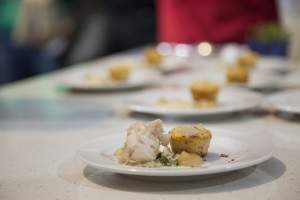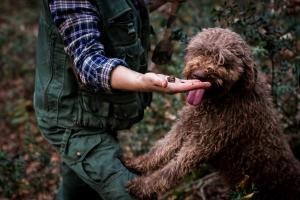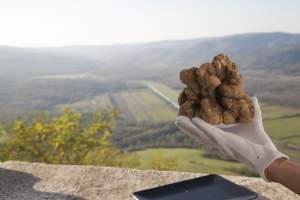Truffle Varieties
Truffles differ mainly in terms of their morphological properties, such as shape, size and colour, the ornamentation of the peridium, the appearance of the gleba, and their smell and flavour.
Currently 63 species of fungus are classified as Tubers. Nine of the 25 which grow in Italy are considered edible, and of these the 6 most commonly found on sale are (*).
White truffle
15.09. - 31.01. Tuber magnatum*
15.01. - 15.05. Tuber borchii
15.01. - 15.04. Tuber asa
01.09. - 31.12. Tuber maculatum
Black truffle
01.11. - 15.03. Tuber melanosporum*
01.10. - 15.03. Tuber brumale*
01.05. - 31.10. Tuber aestivum*
01.09. - 30.04. Tuber mesentericum
01.08. - 31.12. Tuber macrosporum
01.09. - 31.03. Tuber uncinatum
*mostly found varieties in Istria
Tuber magnatum Pico
Prized white truffle
Globose shape, often also very flattened and uneven, with pale yellow or gold peridium and red to brown spots, never grey, smooth or slightly warty. Its gleba, with numerous, very intensely branched white veins, varies from a milky colour to an intense pink. Its spores are alveolated.
It can reach the size of a big apple: few specimens are gathered every year, far over one kilogram in weight. It can be found late in summer, in autumn and early winter under oaks, willow trees, poplars, lime trees, and in grounds with rather high humidity also in summer. Its particular taste and smell have elected him the king of cuisine and have made the world appreciate it. It is eaten uncooked.
Tuber melanosporum Vittadini
Prized black truffle
Globose shape, sometimes lobed, with brown to black peridium, with close warts, hollow on their tops and crossed by longitudinal grooves. Its gleba is brownish grey or reddish black in colour, striped with thin, light, intensely branched veins. Spores are herringbone. It can reach the size of an apple or grow even bigger.
It is gathered during the whole winter period and in particular in the first months of the year, especially under oaks, hazels and hop hornbeams. It is frequent in Italy and Spain but it is gathered and appreciated in France in particular. Its specific taste and its aromatic smell make it very much appreciated in cookery. The French consider it the best and therefore the most valuable among the 'black'. It is preferably eaten a short cooking.
Tuber aestivum Vittadini
Scorzone - Summer truffle
Usually globose in shape or a little lobed, with black peridium and pyramidal warts with apparent cross stripes. Its gleba, always light in colour, varies from pink to brown and is crossed by many white veins. Its spores are alveolated. The largest truffles can be as large as an apple. It is one of the most common truffles; apart from a short break in spring, it can be found all year round also in large quantities, under oaks, hazels, poplars, beeches and pines. Its variety uncinatum Fischer (= Tuber uncinatum Chatin) is more appreciated.
Its scent is light, a little earthy, mushroomy, aromatic and pleasant. Since it is found in plenty, it never reaches the prices of the more valued Tuber melanosporum.
Tuber brumale Vittadini
Winter truffle
Usually globose in sharpe or a little lobed, with black or dark iron peridium, with very close, evident warts, hollow on the top and with longitudinal grooves. Its gleba is dark brown or greyish black with large white veins. Spores are herringbone. It can easily become bigger than a hen's egg.
It can be found in autumn and early winter under oaks and hazels. Its smell and its taste are more or less strong but pleasant (in particular in its variety moschatum Ferry) and make so that it is normally consumed.















